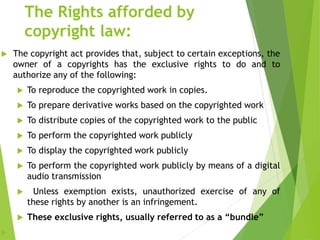Copyright law provides legal protection for original works of authorship fixed in a tangible medium. It gives the author exclusive rights to reproduce, distribute, publicly display, publicly perform, and create derivative works from the copyrighted work. To receive copyright protection, a work must be original and fixed in a tangible medium of expression. Copyright covers original works including literary works, musical works, dramatic works, pantomimes, choreographic works, pictorial/graphic/sculptural works, motion pictures, sound recordings, and architectural works. The rights afforded to copyright owners include reproduction, creation of derivatives, distribution, public performance, and public display. Joint works have joint copyright ownership and works made for hire designate the employer or commissioning party as


![Originality of Material:
To be eligible for copyright protection
Material must be original
Meaning
Independently created
Posses a modicum of creativity
It should not confused with novelty, worthiness
or aesthetic [dealing with beauty] appeal
“Originality” thus does not mean “first”, it
merely means “independently created”,
A slight amount of “creative spark”.](https://image.slidesharecdn.com/iprunit3copyrightsnew1-230925185049-70c59c0d-240321155251-9f16e2cd/85/iprunit3copyrightsnew1-230925185049-70c59c0d-pdf-3-320.jpg)
![Works of Authorship:
The copyright act provides that copyright protection subsists [support
oneself] in original works of authorship fixed in any tangible medium of
expression, now known or hereafter developed, from which they can be
perceived, reproduced or otherwise communicated.
The list is preceded by the phrase that works of authorship “include”
those categories, demonstrating that the listed categories are not only
types of works that can be protected, but are illustrate only
Literary works
Musical works
Dramatic works
Pantomimes and choreographic works
Pictorial, graphic and sculptural works
Motion pictures and other audio-visual works
Sound recording and
Architectural works](https://image.slidesharecdn.com/iprunit3copyrightsnew1-230925185049-70c59c0d-240321155251-9f16e2cd/85/iprunit3copyrightsnew1-230925185049-70c59c0d-pdf-4-320.jpg)


![Rights of Reproduction:
The most fundamental of the rights granted to copyright owners is
the right to reproduce the work
A violation of the copyright act occurs whether or not the violator
profits by the reproduction
Only the owner has the right to reproduce the work
Secretly taping a concert, taking pictures at a performance, or
recording all violate the owner’s right to reproduce
The suggestion of congress, in 1978 a group of authors, publishers
and users established a not-for-profit entity called Copyright
Clearance Center [CCC]
CCC grants licenses to academic, government and corporate users
to copy and distribute the works
It collects royalty fees, which are distributed to the authors
Companies that photocopy articles from journals and magazines
often enter into licensing arrangements with the CCC so they can
make copies.](https://image.slidesharecdn.com/iprunit3copyrightsnew1-230925185049-70c59c0d-240321155251-9f16e2cd/85/iprunit3copyrightsnew1-230925185049-70c59c0d-pdf-7-320.jpg)

![Rights to perform the work
publicly:
Section 106 [5] of the Copyright Act provided that:
in the case of all copyrighted works other than sound
recording & works of architecture, the copyright
owner has the exclusive right to display the work
publicly.
A display is “public” under the same circumstances in
which a performance is “public”.
Namely if it occurs at a place open to the public (or)
at a place where a substantial number of persons
outside of the normal circle of a family.](https://image.slidesharecdn.com/iprunit3copyrightsnew1-230925185049-70c59c0d-240321155251-9f16e2cd/85/iprunit3copyrightsnew1-230925185049-70c59c0d-pdf-9-320.jpg)
![Copyright Ownership Issues:
Copyright in a work protected under the copyright act
vests [provide with power and authority] in the author or
authors of the work
Issues about ownership arise when more than one person
creates a work
Unless copyright has been explicitly conveyed with those
physical articles, the original authors generally retain all
other rights associated with the works.
Ownership of a physical object is separate and distinct from
ownership of the copyright embodied in the material object](https://image.slidesharecdn.com/iprunit3copyrightsnew1-230925185049-70c59c0d-240321155251-9f16e2cd/85/iprunit3copyrightsnew1-230925185049-70c59c0d-pdf-10-320.jpg)
![Ownership Rights in Joint Works:
A joint work is a work prepared by two or more authors
with the intention that their contributions be merged into
inseparable or interdependent parts of a unitary whole.
One copyright exists in the created works
Joint authors are those who “mastermind” or “super mind”
the creative effort.
If individual are authors of a joint work, each owns an
equal undivided interest in the copyright as a tenant in
common, [each has the right to use the work, prepare
derivative works, display it without seeking the other
coauthor’s permission].
If profits arise out of such use, an accounting must be made
so, that each author shares in the benefits or proceeds.
The death of a coauthor, his or her rights pass to heirs who
then own the rights in common with the other coauthor.](https://image.slidesharecdn.com/iprunit3copyrightsnew1-230925185049-70c59c0d-240321155251-9f16e2cd/85/iprunit3copyrightsnew1-230925185049-70c59c0d-pdf-11-320.jpg)











